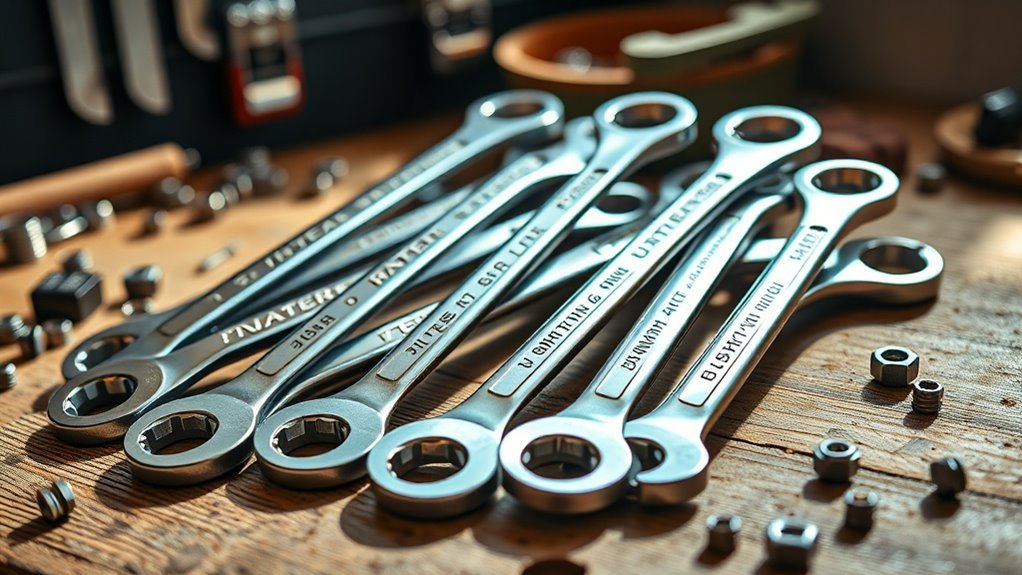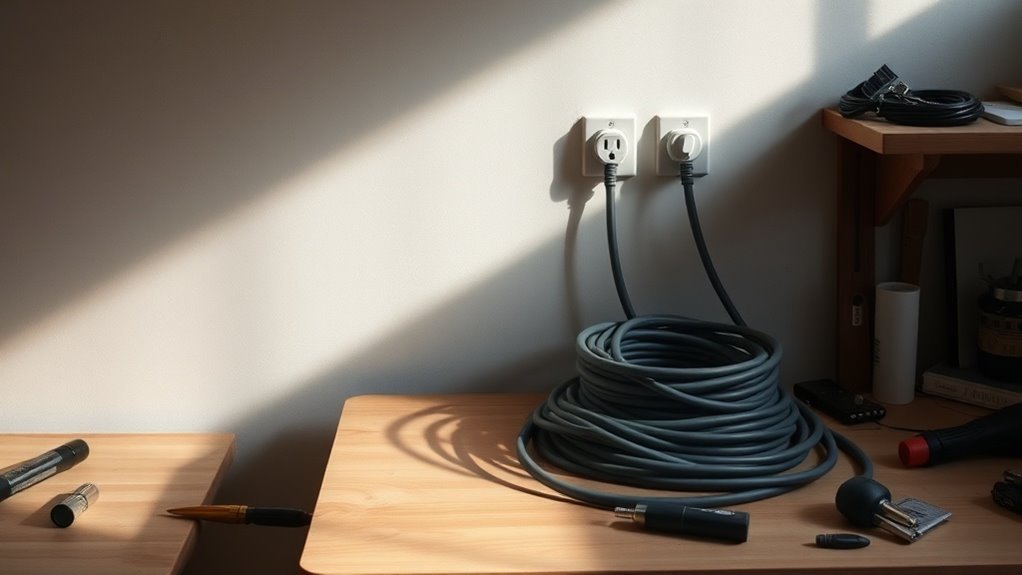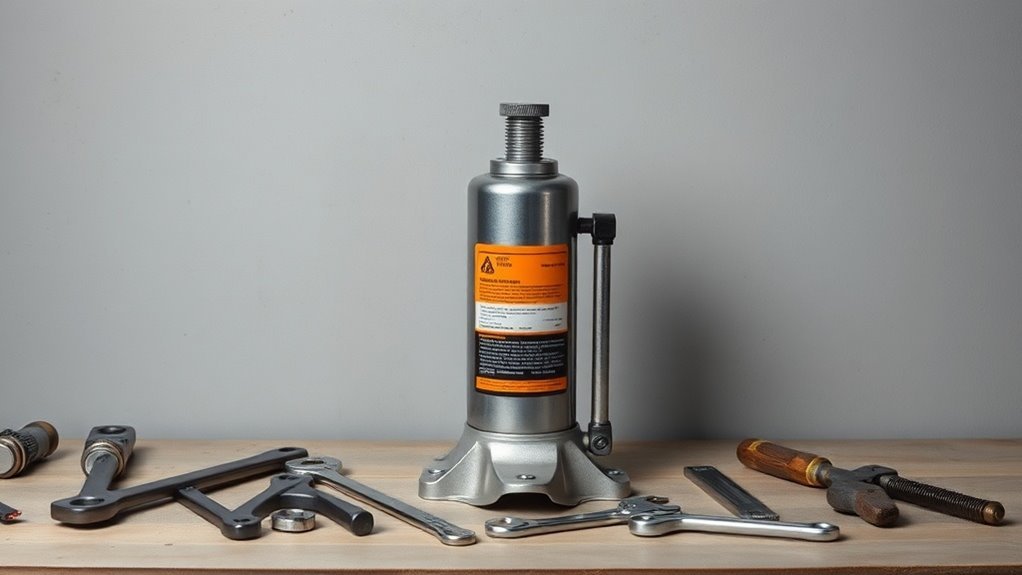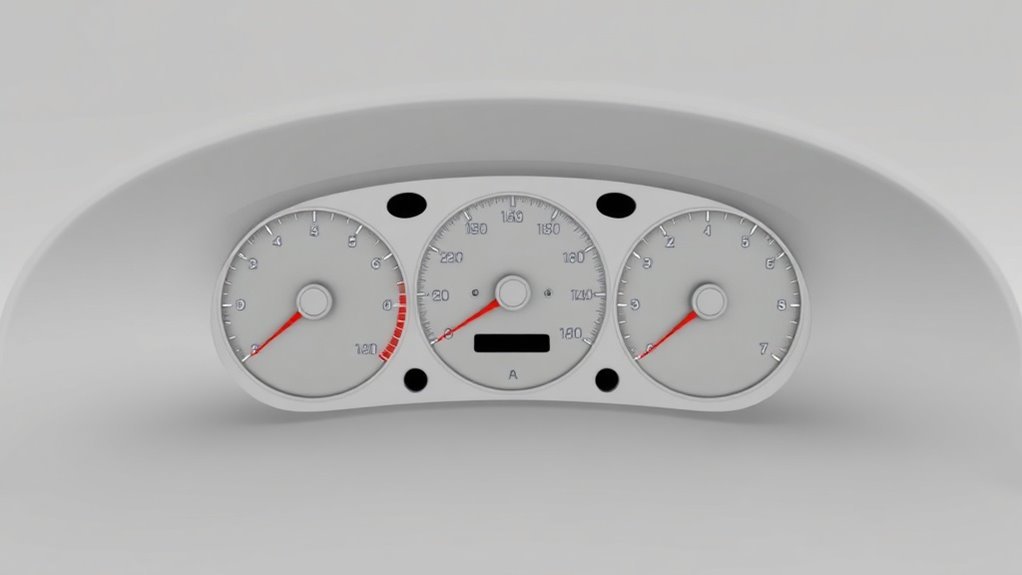Hand Tools Every Car Owner Should Understand
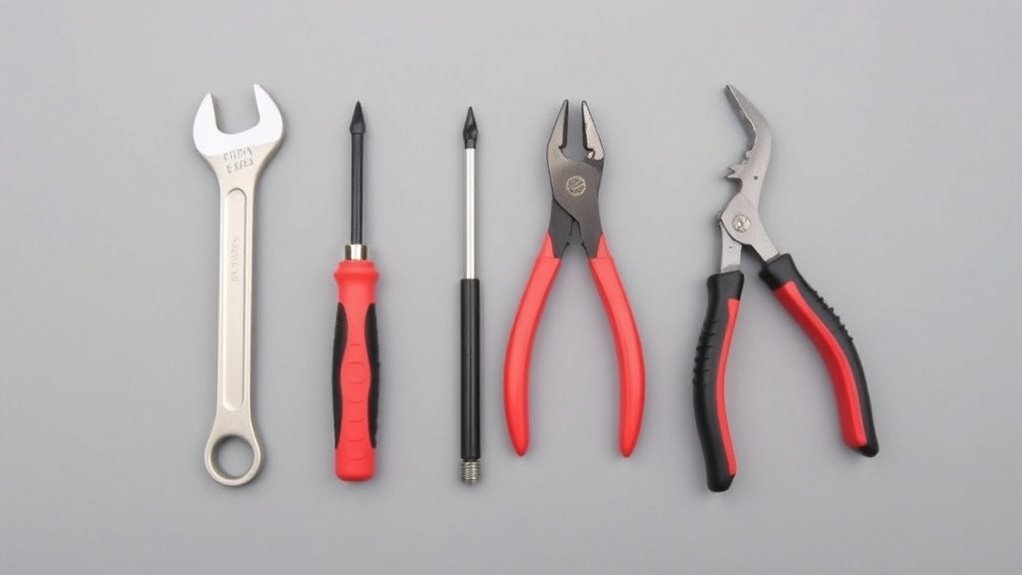
As a car owner, you should understand a few essential hand tools to help you with maintenance and repairs. Socket sets and wrenches are key for loosening and tightening bolts, while screwdrivers and pliers assist in various tasks. A torque wrench guarantees you’re applying the right tension, and pry bars help with stubborn components. Hammers are useful for adjustments, and diagnostic tools give insights into your vehicle’s health. If you want to discover more about these tools and their uses, there’s plenty more to explore.
Key Takeaways
- Socket sets with various sizes and a ratchet wrench are essential for efficient car maintenance in tight spaces.
- Wrenches, including open-end and torque wrenches, provide necessary leverage and accurate force for securing fasteners.
- A reliable set of screwdrivers, including magnetic tip variations, is crucial for various assembly and disassembly tasks.
- Diagnostic tools, like basic scanners, help monitor vehicle health by reading and clearing error codes.
- Proper safety gear, including gloves and safety glasses, is vital for protection during repairs and enhances overall safety.
Socket Sets
When it comes to car maintenance, having a reliable socket set can be a game-changer.
You’ll find that these sets often include a variety of sizes, allowing you to tackle numerous tasks with ease. Whether you’re tightening bolts or removing parts, the right socket can make all the difference.
Look for a set that includes both standard and metric sockets, as this will cover most vehicles. A ratchet wrench paired with your sockets can help you work faster, especially in tight spaces.
A versatile socket set with standard and metric options, along with a ratchet wrench, will enhance your efficiency in tight spots.
Don’t forget the importance of socket extensions and universals; they’ll give you access to tricky areas. Using a socket set not only improves accessibility in tight spaces, but it also enhances your efficiency when working on mechanical tasks.
In the long run, having a quality socket set will save you time, effort, and even money when working on your car.
Wrenches
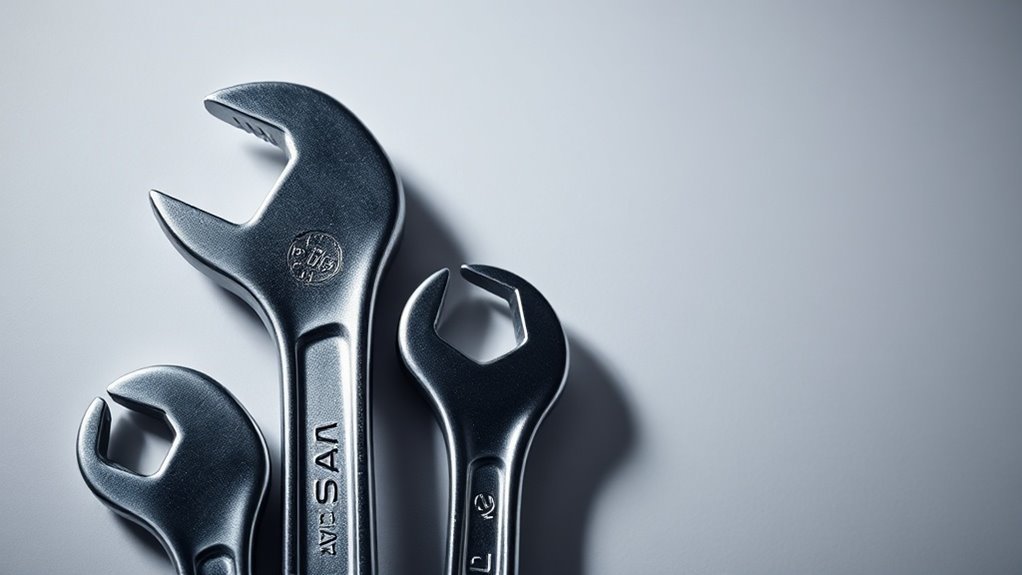
When it comes to wrenches, understanding the different types and how to use them properly is vital for your car maintenance. You’ll also want to know the best ways to care for these tools to keep them in top shape. Additionally, knowing how to utilize leverage mechanics can significantly enhance your efficiency when tackling various tasks. Let’s explore what you need to know about wrenches to make your projects easier and more efficient.
Types of Wrenches
Wrenches are essential tools for car owners, providing the necessary leverage to tighten or loosen bolts and nuts.
Understanding the different types of wrenches can make your tasks easier and more efficient. Here’s a quick overview of common wrenches you might need:
- Open-end wrench: Features two different-sized jaws for gripping nuts and bolts.
- Box-end wrench: Encases the nut for a better grip and reduces slipping.
- Adjustable wrench: Ideal for various sizes, thanks to its movable jaw.
- Torque wrench: Guarantees you apply the right amount of force when tightening.
- Ratchet wrench: Allows for continuous turning without needing to reposition the tool.
Mastering these types will help you tackle most automotive projects with confidence!
Proper Usage Techniques
Using a wrench correctly can considerably enhance your efficiency during automotive repairs. Start by selecting the right size for the fastener; a snug fit prevents slippage and damage. When using a torque wrench, be sure to apply steady pressure while avoiding over-tightening. Always pull the wrench toward you for better control and safety.
Here’s a quick overview of common wrench techniques:
| Technique | Description | Example Use |
|---|---|---|
| Proper Grip | Hold firmly near the jaw | Loosening bolts |
| Steady Pull | Apply pressure in a controlled way | Tightening nuts |
| Correct Angle | Maintain a 90-degree angle | Accessing tight spots |
Mastering these techniques will make your repairs quicker and more effective!
Maintenance and Care
Although many might overlook the upkeep of their tools, proper maintenance of your wrenches is essential for ensuring their longevity and performance.
Regular care not only keeps them in working order but also enhances your efficiency when tackling auto repairs.
To maintain your wrenches, remember to:
- Clean them after each use to remove dirt and grease.
- Store them in a dry place to prevent rust and corrosion.
- Inspect for wear, ensuring the jaws align properly.
- Lubricate moving parts occasionally for smoother operation.
- Avoid using them on excessively tight bolts to prevent damage.
Screwdrivers
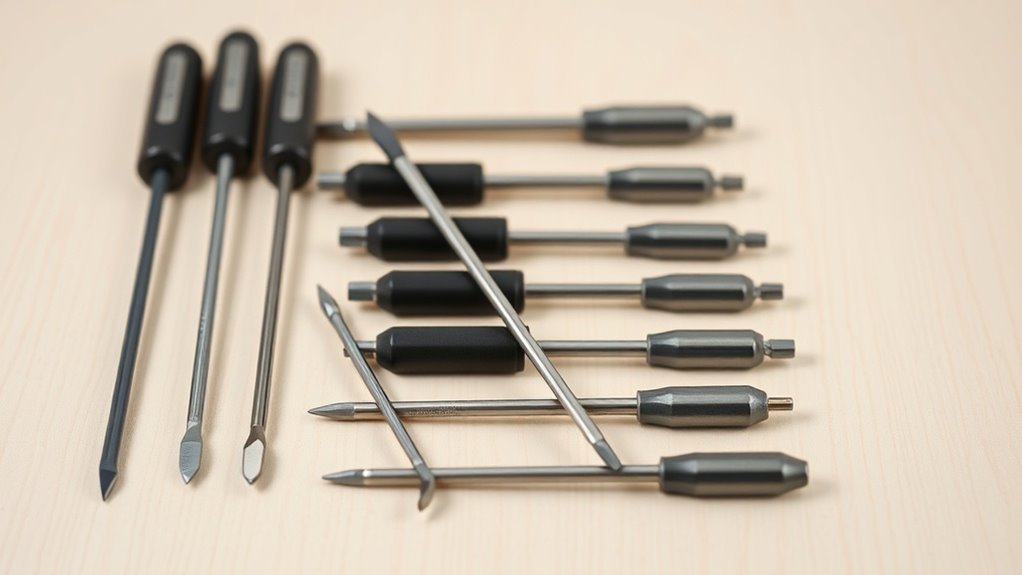
When it comes to tackling basic car repairs, screwdrivers are indispensable tools you’ll want to keep in your toolkit. A good set typically includes both flathead and Phillips screwdrivers, which cover most needs.
When you’re under the hood or working on interior fittings, having the right size is essential to avoid stripping screws.
You’ll often find yourself needing a small screwdriver for delicate tasks, such as removing panels or adjusting components. A ratcheting screwdriver can also save you time by allowing for quick turns without repositioning your grip.
Don’t forget a magnetic tip version, as it can be a lifesaver when you drop screws in hard-to-reach spots. Keeping screwdrivers organized and accessible will make your repairs much smoother. The evolution of screwdrivers has led to a variety of designs and screwdriver heads that enhance their usability in modern automotive tasks.
Pliers
Pliers are essential for any car owner looking to handle a variety of tasks, from gripping and twisting wires to loosening stubborn bolts.
With several types available, having the right pliers can make your job easier and more efficient. Here’s what you should consider:
- Slip-joint pliers: Versatile for gripping different shapes and sizes.
- Needle-nose pliers: Perfect for tight spaces and precision work.
- Locking pliers: Ideal for gripping without slipping, making them great for stubborn fasteners.
- Wire cutters: Useful for snipping wires cleanly and efficiently.
- Crimping pliers: Vital for working with electrical connections.
Having these pliers in your tool kit guarantees you’re ready for various car maintenance tasks. The specialized designs of each type of pliers enhance efficiency and effectiveness in their respective applications.
Make certain to keep them handy!
Torque Wrench
After tackling tasks with your pliers, it’s time to turn your attention to a torque wrench. This tool guarantees you’re applying the correct tension to nuts and bolts, essential for maintaining safety and performance in your vehicle.
Whether you’re replacing a tire, securing engine parts, or working on suspension components, using the right torque is imperative.
A torque wrench comes in various types—click-type, beam-type, and digital. When using one, follow the manufacturer’s specifications for torque settings, which may be found in your vehicle’s manual. Proper use prevents over-tightening, which can strip threads or cause damage.
Using proper torque settings is crucial to prevent damage or failure of components. Always zero your wrench after use to maintain accuracy. With a torque wrench, you can confidently tackle projects knowing everything’s securely in place.
Allen Keys
Allen keys, also known as hex keys, are essential for adjusting fasteners with hexagonal sockets. You’ll often find them in your car for tasks like assembling parts, tightening bolts, or making quick repairs.
They come in various sizes, typically found in sets, so you’ll have the right tool for the job.
- Compact size for easy storage
- Commonly used for securing engine components
- Ideal for assembling car accessories
- Versatile for both metric and imperial fasteners
- Often included in multi-tool sets
Having a set of Allen keys handy guarantees you’re prepared for those unexpected adjustments, keeping your car maintenance smooth and efficient. Additionally, their performance can be optimized with the advantages of brushless motors, which can enhance the efficiency of power tools used for car repairs.
Don’t underestimate these small but mighty tools!
Pry Bars
When it comes to pry bars, you’ll find various types designed for different tasks around your car.
Understanding the proper usage techniques can make your work more efficient and safe.
Let’s explore the different styles and how to use them effectively.
Types of Pry Bars
Whether you’re tackling a DIY repair or just need to pry something open, knowing the different types of pry bars can make a significant difference.
Each type serves specific purposes, helping you handle various tasks with ease. Here are five common types of pry bars to evaluate:
- Flat Pry Bar: Great for removing nails and lifting things.
- Curved Pry Bar: Useful for more aggressive prying and leveraging.
- Utility Pry Bar: Versatile with a flat or curved end for multiple functions.
- Cat’s Paw: Designed specifically for pulling out nails without damaging surrounding wood.
- Tapered Pry Bar: Ideal for reaching into tight spots where other tools can’t fit.
Understanding these will make your projects more efficient and enjoyable.
Proper Usage Techniques
Knowing the different types of pry bars sets a solid foundation for using them effectively.
To start, always choose the right pry bar for your task. Position the bar’s tip at a sturdy point on the object you’re prying. Apply pressure gradually, using your body weight rather than brute force to avoid damaging either the tool or the surface.
When working in tight spaces, use a smaller pry bar for better maneuverability. Keep your hands clear of the prying area to avoid injury.
Finally, store your pry bars properly to keep them in good condition, ensuring they’re ready for your next project. Mastering these techniques will make your automotive tasks smoother and more efficient.
Hammers
Although many car repairs may require specialized tools, a good hammer is still an essential item in any car owner’s toolkit. Hammers come in handy for tasks like adjusting body panels, reseating gaskets, or even removing stubborn parts.
Having a reliable hammer can make a big difference in your repair efforts.
A dependable hammer significantly enhances the efficiency of your car repair tasks.
Here are some types you might find useful:
- Claw Hammer: Great for pulling nails or adjusting parts.
- Ball Peen Hammer: Ideal for shaping metal or tapping in pins and rivets.
- Rubber Mallet: Perfect for non-marring strikes to avoid damage.
- Dead Blow Hammer: Provides controlled force without rebound.
- Sledgehammer: Useful for heavy-duty jobs or dislodging stuck components.
Investing in a good hammer will pay off in your car maintenance journey.
Diagnostic Tools
When it comes to diagnosing your car’s issues, having the right tools can make all the difference.
Basic diagnostic scanners and code readers allow you to quickly identify problems before they become major headaches.
Let’s explore how these tools work and why they’re essential for any car owner.
Basic Diagnostic Scanners
If you’re a car owner, having a basic diagnostic scanner can make a significant difference in maintaining your vehicle’s health. This tool helps you identify issues before they escalate into costly repairs. By connecting it to your car’s OBD-II port, you get real-time data on your vehicle’s performance.
- Read and clear error codes
- Monitor engine performance in real-time
- Access manufacturer-specific diagnostics
- Check for vehicle recalls and updates
- Save money on mechanic visits
Understanding how to use a basic diagnostic scanner empowers you to take charge of your car’s upkeep. You’ll feel more confident diagnosing issues, ensuring your vehicle runs smoothly for longer.
Plus, you’ll become a more informed car owner.
Code Readers Overview
Code readers are essential diagnostic tools that can help you better understand your vehicle’s health. They connect to your car’s onboard diagnostic (OBD) system, allowing you to retrieve trouble codes that indicate issues with various components.
This isn’t just for mechanics; as a car owner, knowing these codes can save you time and money. You can quickly identify problems before heading to a repair shop or even fix minor issues yourself.
Most code readers are user-friendly, and many come with features like live data streams and erase functions.
Safety Gear
While working on your vehicle, having the right safety gear is essential to protect yourself from potential injuries.
Ensuring your safety while working on your vehicle is crucial to prevent injuries.
You might be surprised at how quickly accidents can happen, so preparing yourself is key.
Here are some must-have safety items to contemplate:
- Safety glasses: Protect your eyes from debris and harmful liquids.
- Gloves: Keep your hands safe from sharp edges and chemicals.
- Steel-toed boots: Shield your feet from falling objects and provide better traction.
- Ear protection: Guard against noise pollution from power tools and machinery.
- Dust mask: Prevent inhalation of harmful dust and fumes.
Investing in these essentials will keep you safe and focused on your work, allowing you to tackle those car issues with confidence.
Questions
What Basic Maintenance Tasks Can I Do With These Hand Tools?
You can perform basic maintenance, like changing oil, rotating tires, replacing batteries, and checking fluid levels. With these hand tools, you’ll keep your car running smoothly and save money on minor repairs over time.
How Do I Choose the Right Size Socket for My Vehicle?
Picture a mechanic mastering the art of precision. To choose the right size socket, measure the bolt’s diameter or consult your vehicle’s specifications. You’ll find the perfect fit with ease, ensuring smooth repairs ahead.
Are There Specific Wrenches for Different Car Brands?
Yes, there are specific wrenches designed for different car brands due to varying bolt sizes and shapes. You should check your vehicle’s manual to find the required sizes for better compatibility and ease of use.
What Safety Precautions Should I Take When Using Hand Tools?
Did you know over 400,000 injuries occur annually from hand tool accidents? To stay safe, wear protective eyewear, keep your workspace tidy, and guarantee tools are in good condition before use. Don’t forget proper technique!
How Often Should I Replace My Hand Tools?
You should replace your hand tools when they show signs of wear, damage, or reduced performance. Regularly inspect them, and if they’ve become unreliable or unsafe, it’s time to invest in new ones.
Conclusion
You might think car maintenance is just for mechanics, but with the right hand tools, you can tackle it too. Imagine the satisfaction of fixing a simple issue on your own—like tightening a loose battery cable just in time to start your car on a chilly morning. By understanding these essential tools, you’re not just equipping your garage; you’re building confidence. Who knows, the next time a friend needs help, you might just be their go-to mechanic!


